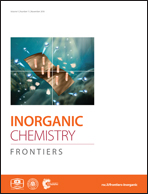Ion-induced structural and optical performance evolution in LBO-like crystals: experimental and theoretical investigation†
Abstract
A new alkali metal borate fluoride Li3KB9O15F has been successfully obtained by the high-temperature solution method in open air for the first time. An X-ray crystallographic study reveals that it crystallizes in the trigonal space group R3c (no. 161), a = 11.974(4) Å, b = 11.974(4) Å, c = 15.998(11) Å and Z = 6. It exhibits a complicated three-dimensional (3D) network composed of LiO3F, KO6F distorted polyhedra and 3D B–O framework. Its UV cut-off edge is below 175 nm. Interestingly, for the crystal structure of LiB3O5, as K+ and F− are introduced in the structure, a new Li3KB9O15F compound is obtained. The structural comparison between LiB3O5 and Li3KB9O15F and the changes in performance caused by the introduction of ions are discussed. The electronic structures and the optical properties have been evaluated using the first-principles methods. After carefully checking the density of the B–O groups and the bandgap, the authors found that the denser B–O groups per unit cell would lead to a deeper UV cutoff edge, which is beneficial for designing novel UV/DUV NLO compounds.



 Please wait while we load your content...
Please wait while we load your content...